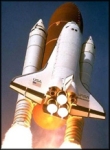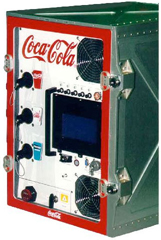Untitled Document
 Space Shuttle Endeavor flight STS-77 contained three different experiments which utilized Diamond Systems' Diamond-MM PC/104 analog I/O modules as part of the experiments' computer-based control systems. The extreme and harsh conditions of a rocket launch, ten days in orbit, re-entry and landing subjected the shuttle, its crew and contents to extreme ranges of temperature, shock and vibration, which required the utmost in reliability of the on-board equipment. Diamond Systems' products were up to the task.
Space Shuttle Endeavor flight STS-77 contained three different experiments which utilized Diamond Systems' Diamond-MM PC/104 analog I/O modules as part of the experiments' computer-based control systems. The extreme and harsh conditions of a rocket launch, ten days in orbit, re-entry and landing subjected the shuttle, its crew and contents to extreme ranges of temperature, shock and vibration, which required the utmost in reliability of the on-board equipment. Diamond Systems' products were up to the task.
The Three Experiments
 The first experiment was the Advanced Organic Materials Separation Process (ADSEP) experiment developed by Space Hardware Optimization Technology (SHOT), Inc. and the University of Alabama's Consortium for Materials Development in Space. The ADSEP experiments were designed to enhance separation technologies for medical products, which are limiting factors in biomedical research and pharmaceutical drug development. The experiments focused on understanding gravitational effects on the manufacture of recombinant hemoglobin products which could have a significant impact on blood transfusion. The ADSEP experiments were conducted in an automated processing facility which provided for manipulation of living cells, cellular particles and proteins. The controlling computer systems utilized two Diamond-MM analog I/O cards to monitor and control temperature and other experimental parameters in the three independently controlled processing modules within the device. The ADSEP system has gone on to fly on a second shuttle flight and again on the International Space Station.
The first experiment was the Advanced Organic Materials Separation Process (ADSEP) experiment developed by Space Hardware Optimization Technology (SHOT), Inc. and the University of Alabama's Consortium for Materials Development in Space. The ADSEP experiments were designed to enhance separation technologies for medical products, which are limiting factors in biomedical research and pharmaceutical drug development. The experiments focused on understanding gravitational effects on the manufacture of recombinant hemoglobin products which could have a significant impact on blood transfusion. The ADSEP experiments were conducted in an automated processing facility which provided for manipulation of living cells, cellular particles and proteins. The controlling computer systems utilized two Diamond-MM analog I/O cards to monitor and control temperature and other experimental parameters in the three independently controlled processing modules within the device. The ADSEP system has gone on to fly on a second shuttle flight and again on the International Space Station.
The second experiment, the Plant Generic Bioprocessing Apparatus (PGBA), was deployed by BioServe Space Technologies, SHOT and Lockheed Martin, and sponsored by a host of research and non-profit organizations. During the ten day flight, the PGBA investigated the change in the production of secondary metabolites in microgravity through a series of experiments measuring a variety of parameters such as biomass accumulation, CO2 use and O2 production. Experiments included the study of Artimisia annua, which produces an anti-malarial compound, and Cataranthus roseus which produces chemotherapeutic compounds. A study was made of the effects of space flight on starch, sugar and fatty acid content of special strains of spinach plants. A forestry products company experimented with the lignin production and reaction in wood formation in loblolly pine, and the nitrogen fixation mechanism in microgravity of clover plants was studied. The PGBA was controlled by an embedded computer system consisting of a PC/104 CPU, a Diamond-MM analog I/O card, a video camera, and an LCD display with touch screen. The PGBA successes aboard flight STS-77 were such that the apparatus flew again on two subsequent shuttle flights and aboard the International Space Station.
 The third experiment, deployed by BioServe Space Technologies and the University of California, and developed in conjunction with the Coca-Cola Company, Lockheed Martin and Ohmeda Corporation, was more refreshing and more commercial in nature. The Fluids Generic Bioprocessing Apparatus-2 (FGBA-2) provided a means of mixing, carbonating and dispensing carbonated beverages under microgravity conditions. The experiment was conducted to determine if carbonated beverages could be produced from separately stored carbon dioxide, water and flavored syrups and if the resulting fluids could be made available for consumption without bubble nucleation and resulting foam formation. The experiment also verified and generated additional data on the effects of space flight on changes in taste perception.
The third experiment, deployed by BioServe Space Technologies and the University of California, and developed in conjunction with the Coca-Cola Company, Lockheed Martin and Ohmeda Corporation, was more refreshing and more commercial in nature. The Fluids Generic Bioprocessing Apparatus-2 (FGBA-2) provided a means of mixing, carbonating and dispensing carbonated beverages under microgravity conditions. The experiment was conducted to determine if carbonated beverages could be produced from separately stored carbon dioxide, water and flavored syrups and if the resulting fluids could be made available for consumption without bubble nucleation and resulting foam formation. The experiment also verified and generated additional data on the effects of space flight on changes in taste perception.
But the most obvious benefit of this payload was the provision to astronauts of tasty beverages which served the important function of increasing hydration levels. This is useful in helping to prevent potentially debilitating side effects of fluid shifts in the human body which can occur during re-entry. For this reason, the apparatus was located near the shuttle's galley and beverages were available to the crew as they desired.
Click here to return to the main article list.